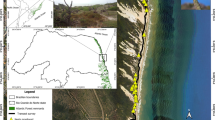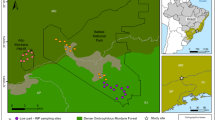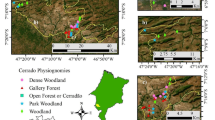Abstract
The deforestation has led to local loss of species and important ecosystem services performed by them, causing ecological and economic losses. It is proposed that the reforestation of such areas aims to reduce those impacts. However, particularly in the tropics, little is known about the real success of different types of reforestation in the recovery of the species, and especially of the population parameters. Here we evaluated whether different types of reforestations affect Trypoxylon (Trypargilum) lactitarse Saussure (Hymenoptera: Crabronidae) in terms of abundance, percentage of emergence, proportion of males, fluctuating asymmetry, and foraging capacity. We compared primary forest (control) data to data collected in five different habitats: pasture, secondary forest, and tree plantations of Teak, Ficus, and a mixture of native species. The abundance of T. lactitarse was higher in tree plantations than in pasture. However, among the analyzed parameters, Teak plantation presented lower emergence percentage and the majority of individuals born were males. The emerged females in this habitat showed higher asymmetry and lower foraging capacity. Ficus showed lower individual abundance and mixed plantation showed lower emergence percentage, with both plantation types showing higher male emergence. On the other hand, in secondary forest, the analyzed parameters did not differ in relation to the primary forest, being the habitat more efficient in relation to those with tree planting. The changes in population parameters of T. lactitarse in different reforestations and particularly on Teak monocultures were probably attributed to indirect effects, such as low food availability and inadequate environmental conditions.





Similar content being viewed by others
References
Abrahamczyk S, Gottleuber P, Matauschek C, Kessler M (2011) Diversity and community composition of euglossine bee assemblages (Hymenoptera: Apidae) in western Amazonia. Biodivers Conserv 20:2981–3001
Alcock J (1975) Social interactions in the solitary wasp, Cerceris simplex (Hymenoptera: Sphecidae). Behavior 54:142–152
Araujo GJ, Fagundes R, Antonini Y (2017) Trap-nesting hymenoptera and their network with parasites in recovered Riparian forests Brazil. Neo Entomol 47:26–36. https://doi.org/10.1007/s13744-017-0504-4
Assis JMF, Camillo E (1997) Diversidade, sazonalidade e aspectos biológicos de vespas solitárias (Hymenoptera: Sphecidae: Vespidae) em ninhos armadilhas na região de Ituiutaba. An Soc Entomol Bras 26:335–347
Banaszak-Cibicka W, Fliszkiewicz M, Langowska ZM (2018) Body size and wing asymmetry in bees along an urbanization gradient. Apidologie 49:297–306
Barral MP, Benayas JMR, Meli P, Maceira NO (2015) Quantifying the impacts of ecological restoration on biodiversity and ecosystem services in agroecosystems: a global meta-analysis. Agri Eco Envirol 202:223–231
Benítez HA (2013) Assessment of patterns of fluctuating asymmetry and sexual dimorphism in carabid body shape. Neo Entomol 42:164–169
Bennett DM, Hoffmann AA (1998) Effects of size and fluctuating asymmetry on field fitness of the parasitoid Trichogramma carverae (Hymenoptera: Trichogrammatidae). J Anim Ecol 67:580–591
Beyer WN, Miller GW, Fleming WJ (1987) Populations of trap-nests wasps near a major source of fluoride emissions in Western Tennessee. Proc Entomol Soc Wash 89:478–482
Bohart RM, Menke AS (1976) Sphecid wasps of the world a generic revision. University of California Press, London, p 660
Brockmann HJ, Grafen A (1992) Sex rations and life-history patterns of a solitary wasp, Trypoxylon (Trypargilum) politum (Hymenoptera: Sphecidae). Behav Ecol Sociobiol 30:7–27
Bueno AF, Paula-Moraes SV, Gazzoni DL, Pomari AF (2013) Economic thresholds in soybean-integrated pest management: old concepts, current adoption, and adequacy. Neo Entomol 42:439–447
Buschini MLT (2007) Life-history and sex allocation in Trypoxylon (syn. Trypargilum) lactitarse (Hymenoptera; Crabronidae). J Zool Syst Evol Res 45:206–213
Buschini MLT, Bergamaschi ABC (2014) Sex ratio and parental investment in Trypoxylon (Trypargilum) agamemnon Richards (Hymenoptera, Crabronidae). Braz J Biol 74:231–237
Buschini MLT, Donatti AJ (2012) Nesting behavior of Trypoxylon (Trypargilum) agamemnon Richards (Hymenoptera: Crabronidae). Braz J Biol 72:353–362
Buschini MLT, Wolff LL (2006) Notes on the biology of Trypoxylon (Trypargilum) opacum Brethes (Hymenoptera: Crabronidae) in southern Brazil. Braz J Biol 66:915–926
Buschini MLT, Lazzarini LW, Niesting F (2006) Nesting biology of Trypoxylon (Trypargilum) lactitarse (Hymenoptera; Crabronidae) in trap-nests in southern Brazil. Braz J Biol 66:161–171
Buschini MLT, Borda NA, Brescovit AD (2008) Patterns of prey selection of Trypoxylon (Trypargilum) lactitarse Sausurre (Hymenoptera: Crabronidae) in southern Brazil. Braz J Biol 68:519–528
Buschini MLT, Caldas TR, Borba NA, Brescovit AD (2010) Spiders used as prey by the hunting wasp Trypoxylon (Trypargilum) agamemnon Richards (Hymenoptera: Crabronidae). Zool Stud 49:169–175
Byrne DN, Buchmann SL, Spangler HG (1988) Relationship between wing loading, wingbeat frequency and body mass in homopterous insects. J Exp Biol 135:9–24
Camillo E, Brescovit AD (1999) Aspectos biológicos de Trypoxylon (Trypargilum) lactitarse Saussure e Trypoxylon (Trypargilum) rogenhoferi Kohl (Hymenoptera: Sphecidae) em ninhos-armadilhas, com especial referência a suas presas. An Soc Entomol Bras 28:251–262
Camillo E, Garofalo CA, Serrano JC, Muccillo G (1995) Diversidade e abundância sazonal de abelhas e vespas solitárias em ninhos armadilhas (Hymenoptera: Apocrita: Aculeata). Rev Bras Entomol 39:459–470
Chang CH, Lin YH, Chen IH, Chuang SC, Chen JH (2007) Taxonomic re-evaluation of the Taiwanese montane earthworm Amynthas wulinensis Tsai, Shen & Tsai, 2001 (Oligochaeta: Megascolecidae): polytypic species or species complex? Org Divers Evol 7:231–240
Charnov EL (1982) The theory of sex allocation. Princeton University Press, Princeton, p 355
Chazdon RL (2003) Tropical forest recovery: legacies of human impact and natural disturbances. Perspect Plant Ecol Evol Syst 6:51–71
Clarke GM (1993) Patterns of developmental stability of Chrysopa perla L. (Neuroptera: Chrysopidae) in response to environmental pollution. Environ Entomol 22:1362–1366
Clarke GM, Brand GW, Whitten MJ (1986) Fluctuating asymmetry: a technique for measuring developmental stress caused by inbreeding. Aust J Biol Sci 39:145–153
Coelho JR, Holliday CW (2001) Effects of size and flight performance on intermale mate competition in the cicada killer, Sphecius speciosus (Hymenoptera: Sphecidae). J Insect Behav 14:345–351
Coville RE (1981) Biological observations on three Trypoxylon wasps in the subgenus Trypargilum from Costa Rica: T. nitidum schultessi, T. saussurei and T. lactitarse (Hymenoptera: Sphecidae). Pan Pac Entomol 57:332–340
Coville RE (1982) Wasps of the genus Trypoxylon subgenus Trypargilum in North America. University of California Press, Berkeley, p 163
Crawley MJ (2007) The R book. Imperial College London, Silwood Park Chichester, p 1080
Crozier RH, Pamillo P (1996) One into two will go. Nature 383:574–575
Didham RK (1997) The infuence of edge effects and forest fragmentation on leaf-litter invertebrates in Central Amazonia. In: Laurance WF, Bierregaard RO (eds) Tropical forest remnants: ecology, Manag Cons Frag Communt Chicago, pp 55–70
Didham RK (1998) Altered leaf-litter decomposition rates in tropical forest fragments. Oecologia 116:397–406
Dunne T, Western D, Dietrich WE (2011) Effects of cattle trampling on vegetation, infiltration, and erosion in a tropical rangeland. J Arid Environ 75:58–69
Dutra S, Marco P (2015) Bionomic differences in odonates and their influence on the efficiency of indicator species of environmental quality. Ecol Indic 49:132–142
Edge DA (2005) Butterfly conservation in the southern Cape. Metamorphosis 16:28–46
Endler JA (1977) Geographic variation, speciation and clines. Monogr Popul Biol 10:1–246
Engelbrecht IA (2010) Invertebrate species inventories in protected area management: are they useful? Afr Entomol 18:235–245
Evans HE, Eberhard MJ (1970) The wasps. The University of Michigan Press, Ann Arbor, p 265
Falcão CF, Dátillo W, Izzo TJ (2015) Efficiency of different planted forests in recovering biodiversity and ecological interactions in Brazilian Amazon Forest. For Ecol Manag 339:105–111
Fearnside PM (2006) Deforestation in Amazonia: dynamics, impacts and control. Acta Amaz 36:395–400
Fearnside P, Figueiredo A (2017) China’s influence on deforestation in Brazilian Amazonia: a growing force in the State of Mato Grosso. In: Ray R, Gallagher K, Lopez A, Sanborn C (eds) China and sustainable development in Latin America: the social and environmental dimension, London, pp 229–266
Fisher RA (1958) The genetical theory of natural selection. The Clarendon Press, New York, p 308
Fontaine C, Dajoz I, Meriguet J, Loreau M (2006) Functional diversity of plant–pollinator interaction webs enhances the persistence of plant communities. PLoS Biol 4:129–135
Gathman A, Tscharntke T (2002) Foraging ranges of solitary bees. J Anim Ecol 71:757–764
Gibbs HK, Ruesch AS, Achard F, Clayton MK, Holmgren P, Ramankutty N, Foley JA (2010) Tropical forests were the primary sources of new agricultural land in the 1980s and 1990s. PNAS 107:16732–16737
Godfray HCJ (1988) Virginity in haplodiploid populations: a study on lig wasps. Eco Entomol 13:283–291
Guariguata MR, Ostertag R (2001) Neotropical secondary forest succession: changes in structural and functional characteristics. For Ecol Manag 148:185–206
Hamilton WD (1979) Wingless and fighting males in fig wasps and other insects. In: Blum MS, Blum NA (eds) Reproductive competition and sexual selection in insects. Academic Press, London, pp 167–220
Hardy ICW, Dijkstra LJ, Gillis JEM, Luft PA (1998) Patterns of sex ratio, virginity and developmental mortality in gregarious parasitoids. Biol J Linn Soc 64:239–270
Hardy ICW, Stokkebo S, Bùnlùkke-Pedersen J, Sejr MK (2000) Insemination capacity and dispersal in relation to sex allocation decisions in Goniozus legneri (Hymenoptera: Bethylidae): why are there more males in larger broods? Ethology 106:1021–1032
Ho GWC, Leung KMY, Lajus D, Ng JSS, Chan BKK (2009) Fluctuating asymmetry of Amphibalanus (Balanus) amphitrite (Cirripedia: Thoracica) in association with shore height and metal pollution. Hydrobiologia 621:21–32
Kemp DJ, Alcock J (2008) Aerial contests, sexual selection and flight morphology in solitary Pompilid wasps. Ethology 114:195–202
Klein AM, Steffan-Dewenter I, Tscharntke T (2002) Effects of land-use intensity in tropical agroforestry systems on flower-visiting and trap-nesting bees and wasps. Conserv Biol 16:1003–1014
Krombein KV (1967) Trap-nesting wasps and bees: life histories, nests and associates. Washington, p 569
Kurn D, Bretz S, Akbari H (1994) The potential for reducing urban air temperatures and energy consumption through vegetative cooling. ACEEE summer study on Energy Efficiency in Buildings, America Council for an Energy Efficient Economy. Pacific Grove: American Council for an Energy Efficient Economy. http://www.osti.gov/bridge/servlets/purl/10180633-hLSlld/native/10180633.pdf. Accessed 11 August 2017
Lack JB, Monette MJ, Johanning EJ, Sprengelmeyer QD, Pool JE (2015) Decanalization of wing development accompanied the evolution of large wings in high-altitude Drosophila. PNAS 113:1014–1019
Laurance WF, Camargo JLC, Luizão RCC, Laurance SG, Pimm SL, Bruna EM, Stouffer PC, Bruce Williamson G, Benítez-Malvido J, Vasconcelos HL, van Houtan KS, Zartman CE, Boyle SA, Didham RK, Andrade A, Lovejoy TE (2011) The fate of Amazonian forest fragments: a 32-year investigation. Bio Conserv 144:56–67
Leung B, Forbes MR (1996) Fluctuating asymmetry in relation to stress and fitness: effects of trait type as revealed by meta-analysis. Ecoscience 3:400–413
Lobregat G, Perilli MLL, Neves F, Campos R (2017) Fluctuating asymmetry, leaf thickness and herbivory in Tibouchina granulosa: an altitudinal gradient analysis. Arthropod Plant Interact 12:277–282. https://doi.org/10.1007/s11829-017-9568-7
Loyola RD, Martins RP (2008) Habitat structure components are effective predictors of trap-nesting Hymenoptera diversity. Basic Appl Ecol 9:765–742
Marden JH (1989) Body building dragonflies: costs and benefits of maximizing flight muscle. Physiol Zool 62:505–521
McGeoch MA, Sithole H, Samways MJ, Simaika JP, Pryke JS, Picker M, Uys C, Armstrong AJ, Dippenaar-Schoeman AS, Engelbrecht IA, Braschler B, Hamer M (2011) Conservation and monitoring of invertebrates in terrestrial protected areas. Koedoe 53:1–13
Miklasevskaja M, Packer L (2015) Fluctuating asymmetry in am extreme morphological adaptation in the Chilean bee Xeromelissa rozeni (Hymenoptera: Colletidae). Can J Zool 93:833–840
Mitchell MG, Suarez-Castro AF, Martinez-Harms M, Maron M, McAlpine C, Gaston KJ, Johansen K, Rhodes JR (2015) Reframing landscape fragmentation’s effects on ecosystem services. Trends Ecol Evol 30:190–198
Mitton JB, Grant MC (1984) Association among protein heterozygosity, growth rate and developmental homeostasis. Ann Rev Ecol System 15:479–499
Molumby A (1997) Why make daughter larger? Maternal sex-allocation and sex-dependent selection for body size in a mass-provisioning wasp Trypoxylon politum. Behav Ecol 8:279–287
Morato EF (2001) Biologia e ecologia de Anthodioctes moratoi Urban (Hymenoptera, Megachilidae, Anthidiini) em matas contínuas e fragmentos na Amazônia Central, Brasil. Rev Bras Zool 18:729–736
Morato EF, Campos LAO (2000) Efeitos da fragmentação florestal sobre vespas e abelhas solitárias em uma área da Amazônia Central. Rev Bras Zool 17:429–444
Newbold T, Hudson LN, Hill SLL, Contu S, Lysenko I, Senior RA, Börger L, Bennett DJ, Choimes A, Collen B, Day J, de Palma A, Díaz S, Echeverria-Londoño S, Edgar MJ, Feldman A, Garon M, Harrison MLK, Alhusseini T, Ingram DJ, Itescu Y, Kattge J, Kemp V, Kirkpatrick L, Kleyer M, Correia DLP, Martin CD, Meiri S, Novosolov M, Pan Y, Phillips HRP, Purves DW, Robinson A, Simpson J, Tuck SL, Weiher E, White HJ, Ewers RM, Mace GM, Scharlemann JPW, Purvis A (2015) Global effects of land use on local terrestrial biodiversity. Nature 520:45–50
Nichols E, Larsen T, Spector S, Davis AL, Escobar F, Favila M, Vulinec K (2007) Global dung beetle response to tropical forest modification and fragmentation: a quantitative literature review and meta-analysis. Bio Conserv 137:1–19
Niemi GJ, McDonald ME (2004) Application of ecological indicators. An Rev Ecol Evol Syst 35:89–111
Nunney L, Luck RF (1988) Factors influencing the optimum sex ratio in structured populations. J Theor Biol 33:1–30
Oliveira-Nascimento AL, Garófalo CA (2014) Trap-nesting solitary wasps (Hymenoptera: Aculeata) in an insular landscape: mortality rates for immature wasps, parasitism, and sex ratios. Sociobiology 61:207–217
Padula RC, Silva LP (2005) Gestão e licenciamento ambiental no Brasil: modelo de gestão focado na qualidade do meio ambiente. Cadernos EBAPE.BR, Rio de Janeiro, pp 1–15
Palmer AR, Strobeck C (1986) Fluctuating asymmetry: measurement, analysis, patterns. Annu Rev Ecol Syst 17:391–421
Pearce JL, Venier LA (2006) The use of ground beetles (Coleoptera: Carabidae) and spiders (Araneae) as bioinidcators of sustainable forest management: a review. Ecol Indic 6:780–793
Pérez-Maluf R (1993) Biologia de vespas e abelhas solitárias, em ninhos armadilhas em Viçosa - MG. Dissertation, Universidade Federal de Viçosa
Pinto NS, Juen L, Cabette HSR, Júnior PM (2012) Fluctuating asymmetry and wing size of Argia tinctipennis Selys (Zygoptera: Coenagrionidae) in relation to riparian forest preservation status. Neo Entomol 41:178–185
Piscart C, Moreteau JC, Beisel JN (2005) Biodiversity and structure of macroinvertebrate communities along a small permanent salinity gradient (Meurthe River, France). Hydrobiologia 551:227–236
Pitilin RB, Araújo MS, Buschini MLT (2012) Individual specialization in the hunting-wasp Trypoxylon (Trypargilum) agamemnon Richards (Hymenoptera: Crabronidae). Zool Stud 51:655–662
Polidori C, Santoro D, Bluthgen N (2013) Does prey mobility affect niche width and individual specialization in hunting wasps? A network-based analysis. Oikos 122:385–394
R Development Core Team R (2018) A language and environment for statistical computing. Version 3.5.1 [software]. User’s guide and application published http://www.R-project.org
Rodrigues DJ, Izzo TJ, Battirola LD (2011) Descobrindo a Amazônia Meridional: Biodiversidade da Fazenda São Nicolau. Pau e Prosa Comunicação, Cuiabá, p 301
Samejima Y, Tsubaki Y (2010) Body temperature and body size affect flight performance in a damselfly. Behav Ecol Sociobiol 64:685–692
Sanseverino AM, Nessimian JL (2008) Larvas de Chironomidae (Diptera) em depósitos de folhiço submerço em um richo de primeira ordem da Mata Atlântica (Rio de Janeiro, Brasil). Rev Bras Entom 52:95–104
Sheldon BC, Merilä J, Lindgren G, Ellegren H (1998) Gender and environmental sensitivity in nestling collared flycatchers. Ecol press 79:1939–1948
Shintarou O, Takayoshi N (1999) Factors affecting female-biased sex ratio in a trap-nesting wasp, Trypoxylon malaisei. Rev Popul Ecol 41:169–175
Steffan-Dewenter I, Tscharntke T (2002) Insect communities and biotic interactions on fragmented calcareous grassland: a mini review. Biol Conserv 104:275–284
Strohm E, Linsenmair KE (1999) Measurement of parental investment and sex allocation in the European beewolf Philanthus triangulum F. (Hymenoptera: Sphecidae). Behav Ecol Sociobiol 47:76–88
Swaddle JP (1996) Reproductive success and symmetry in zebra finches. Anim Behav 51:203–210
Swaddle JP, Witter MS, Cuthill A, McCowen P (1997) Plunage condition affects flight performance in starlings: implications for developmental homeostasis, abrasion and moult. J Avian Biol 27:103–111
Thomas ALR (1993) On the aerodynamics of birds’ tails. Philos Trans R Soc Lond B 340:361–380
Tomkins JL, Kotiaho JS (2001) Fluctuating asymmetry. Encyclopedia of life and sciences. https://doi.org/10.1038/npg.els.0003741
Tscharntke T, Gathmann A, Steffandewenter I (1998) Bioindication using trap-nesting bees and wasps and their natural enemies: community structure and interactions. J Appl Ecol 35:708–719
Tylianakis JM, Klein AM, Tscharntke T (2005) Spatiotemporal variation in the effects of a tropical habitat gradient on Hymenoptera diversity. Ecology 86:3296–3302
Uetz GW, Halaj J, Cady AB (1999) Guild structure of spiders in major crops. J Arachnol 27:270–280
Uhl C, Clark K, Maquirino P (1988) Vegetation dynamics in Amazonian treefall gaps. Ecology 69:751–763
Uys C, Hamer M, Slotow R (2006) The effect of burn area on invertebrate recolonisation in grasslands in the Drakensberg, South Africa. Afr Zool 41:51–65
Vandenbussche PSP, Spennato G, Pierson PM (2018) Assessment of the use of Oblada melanura (L. 1758) otolith fluctuating asymmetry as environmental disturbance indicator. Mar Environ Res 136:48–53
Vangestel C, Braeckman BP, Matheve H, Lens L (2011) Constraints on home range behaviour affect nutritional condition in urban house sparrows (Passer domesticus). Biol J Linn Soc 101:41–50. https://doi.org/10.1111/j.1095-8312.2010.01493.x
Yao I (2011) Phylogenetic comparative methods reveal higher wing loading in ant-attended Tuberculatus aphids (Hemiptera: Aphididae). Can Entomol 143:34–43
Zurbuchen A, Bachofen C, Müller A, Hein S, Dorn S (2010) Are landscape structures insurmountable barriers for foraging bees? A mark-recapture study with two solitary pollen specialist species. Apidologie 41:497–508
Acknowledgments
We highly acknowledge the Office National des Forêts of Brazil for the logistical support and Coordenação de Aperfeiçoamento de Pessoal de Nível Superior for the scholarships provided to GJA.
Author information
Authors and Affiliations
Contributions
GJA, DST and TJI Conceptualization, GJA, DST and TJI Data curation, GJA, DST and TJI Formal analysis, TJI Funding acquisition, GJA, DST and TJI Investigation, GJA and TJI Methodology, TJI Project administration, TJI Resources, TJI Supervision, GJA, DST and TJI Validation, GJA, DST and TJI Visualization, GJA and TJI Writing (original draft preparation), GJA, DST and TJI Writing (review and editing).
Corresponding author
Additional information
Edited by Heraldo Vasconcelos – UFU
Publisher’s Note
Springer Nature remains neutral with regard to jurisdictional claims in published maps and institutional affiliations.
Rights and permissions
About this article
Cite this article
de Araújo, G.J., Storck-Tonon, D. & Izzo, T.J. Is Planting Trees Enough? The Effect of Different Types of Reforestation on the Offspring of Trypoxylon (Trypargilum) lactitarse (Hymenoptera: Crabronidae) in the Southern Amazon. Neotrop Entomol 48, 572–582 (2019). https://doi.org/10.1007/s13744-019-00682-9
Received:
Accepted:
Published:
Issue Date:
DOI: https://doi.org/10.1007/s13744-019-00682-9




